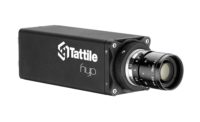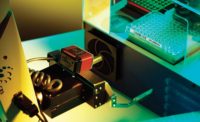Profile sensors and smart cameras are two products with different technologies that have some overlap in their applications. This can make it difficult to determine which to use and when. This article will give a brief overview on the different technologies that each system employs as well as review example applications to demonstrate when it is appropriate to use one over the other.
Profile Sensors
A profile sensor measures the distance to the surface of an object along a laser line it emits. This line is the sensor’s field of view (FOV) and it can measure the height of various points within that FOV, thus creating an outline of the surface of the object.
Technology
Profile sensors use triangulation to determine distances to an object. The sensor emits a laser line that hits an object and reflects back to the sensor. It then passes through a lens and subsequently hits a 2D array of pixels. By determining where the laser hits the array, the sensor can determine the distance to an object at multiple points thus mapping its profile.
Software
Certain algorithms within the software can then pick up different characteristics of the profile along that line. These can include edges on an object, maximum height, minimum height, etc. Different profile sensors have different algorithms built in. Some are made to detect circular objects. Others are made to detect edges. Others measure the largest change in distances (max-min).
Smart Cameras
A smart camera is a vision system with a built-in processor. Sometimes called a vision sensor, it is very much a vision system based around a camera with processing powers. In this way, it is a self-contained unit. It was designed to reduce the complexity of a traditional PC based vision system where cameras take images and send them to a computer to be processed. In the typical smart camera, lighting, lensing, and processing all take place within the camera unit. This makes the system much less complicated and cost effective.
Technology
The technology behind a smart camera is based on the same technology as any digital camera. A lens focuses the image and lets light into the camera where it hits a 2D pixel sensor. Pixels receive a value from 0 (pure black) to 255 (pure white), depending on the amount of light that they receive. Together, all these pixels create an image.
Software
Once an image is formed, the smart camera can process the image using a variety of tools. For example, it can look for pre-trained patters, test the average brightness of a certain area within the image, or measure the distance from one area to another. Much in the same way that profile sensors have built in software, the smart camera software is built into the camera.
Example: Height Measurement
Now that we understand the technology behind each product, we can determine when to use them. The following are a series of examples that highlight the differences of the two products when it comes to solving applications.
Application: Checking closure of toothpaste tubes
Any application that requires a height measurement should be done with profile sensors. Strictly height-based measurements cannot be performed by a vision system as there is no way to tell how far away the camera is from the object. If an object varies in its distance to the sensor, a vision system won’t be able to account for this movement. It will “see” the object as bigger or smaller as the distance changes and therefore its software tools will be affected. A profile sensor has this measuring capability built in and therefore should always be considered for applications with height measurements. Winner = Profile Sensors
Example: Width Measurement
Application: Checking the width of tape on a web
Some applications can be solved with either a camera or a profile sensor. The following rules are a good guide to recognizing these instances.
The object is consistently presented at a fixed distance from sensor/camera.
The object is oriented (not rotated) and consistently passes through the profile sensor’s FOV. A profile sensor cannot locate parts (see the next example for camera fixturing). It can only “see” what directly passes through its laser beam.
If these conditions are met, then either product should work. As we’ll see in the conclusion, in these cases a profile sensor makes more sense. Winner = Profile Sensors
Example: Fixturing and Mounting Limitations
Application: Machined parts not presented consistently
As mentioned in Example 2, a profile sensor won’t be able to locate a part, but a smart camera can. If parts are not being presented consistently, a profile sensor won’t be able to measure the correct widths or distances. A camera can take an image, locate the part within the image, and then apply measuring tools in the correct locations.
Another advantage for the camera is a greater freedom in mounting. Although the camera itself is typically larger than the sensor, it can be mounted closer or further to the object thanks to a variety of lenses. Profile sensors have blind spots directly in front of them for some distance as well as a limit to their range. If mounting distances are an issue, vision systems have more options. Winner = Smart Cameras
Example: Complex Inspection
Application: Depth of plunger inside tube
Consider this example. The depth of a plunger inside a glass tube is being measured. A profile sensor would only be able to measure the profile of the glass tube whereas a smart camera can see through the tube to the plunger within. This is one example of many where an application becomes too complicated for profile sensors and a smart camera becomes more appropriate.
Multiple inspections on a single part is another example of complexity. A smart camera allows many tools to be processed on one image whereas several profile sensors may be required to complete the same inspections. Of course, any application with code or text reading along with many other tools that a vision system can perform would be impossible for a profile sensor and should be looked at through the lens of a smart camera. Winner = Smart Cameras.
Conclusions
Both profile sensors and smart cameras are incredibly powerful and useful products that can solve a wide range of applications. Some of these applications can be solved with both. However, sensors in general will always be easier to use and typically similarly priced. These are the main reasons you should always use a profile sensor if possible. The examples above can serve as a guide to choosing the correct product. When in doubt, try solving with a profile sensor first and then escalating to a smart camera. V&S









